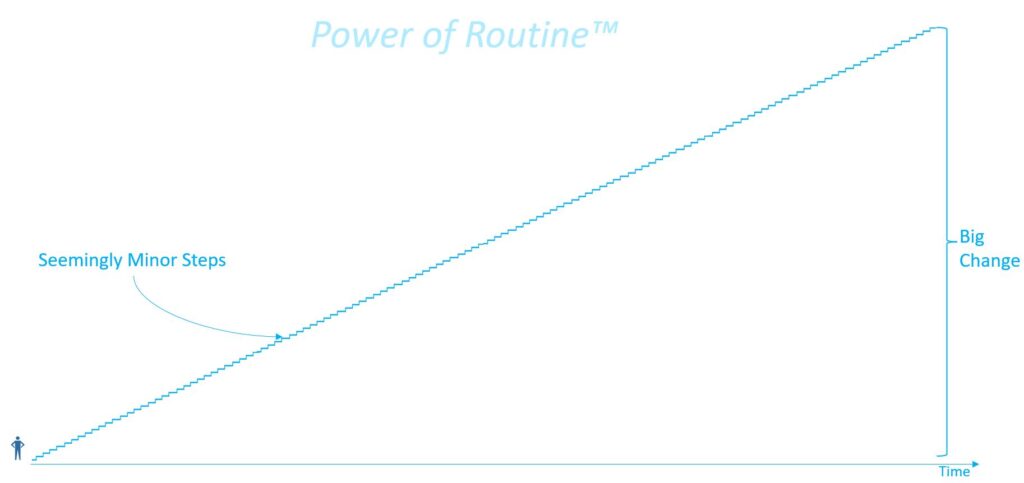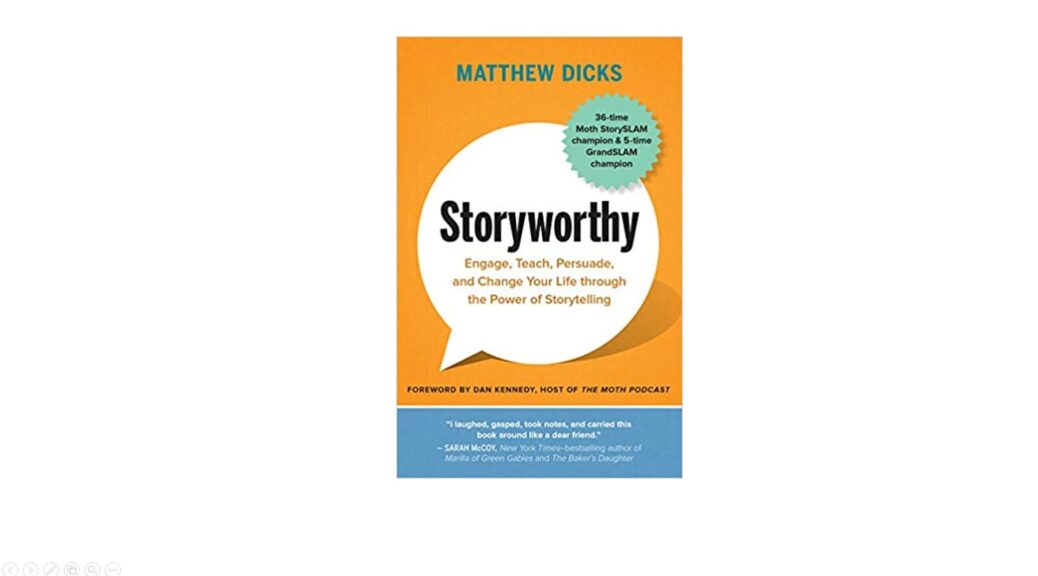Rule #1: The Main Character Must Undergo Change
- Your first idea for how 2 fix a writers block is rarely ever the best. Think about how you can engineer your story to maximize the fun…
- You have to find the piece of the story that we can connect with. Drinking stories and vacation stories are not good because they are a series of ANDs…I did this and this….us But & Therefore, Cause/Effect.
- Your story should be tell-able at a dinner party: KISS = keep it simple, smartie-pants.
- You should practice telling your canned stories at said dinner party. But never in front of a mirror that’s not how you’ll tell it in the wild.
Rule #2: Harvest the Mundane & Audiences will Connect
- People want to engage by seeing themselves in that story. Just say no to jumping out of an airplane, epic adventure and say yes to arguing with your spouse about the dishwasher! Make your story little.
- Create a spreadsheet called the Homework4Life™: column 1: date, column 2: write a snippet about the most eventful part of your day.
- Write down snippets from your live memories when they pop into your mind so that you can harvest later.
- Self-discovery requires the reflection habit to form which means taking 15 minutes a day. It takes time to hone in on your stories. §Harvest in your daily life and you will find other memories.

Rule #3: Homework4Life™ Is Better Than Anything
- Use stream of consciousness to populate your Homework4Life™ spreadsheet on a daily.
- Forget what the education system has taught you: ie. to have a main message (thesis) and your arguments to back that thesis. This approach is deeply alienating. §Use a pen/keyboard or speech-to-text into your phone so that there are no pauses.
- If you have pauses/writers block start listing colours until a new memory is triggered based on association. §Storytellers needs to selfishly guard their time: that means early morning or a locked door.
Rule #4: Unearth Stories with First / Last / Best / Worst
- Create a spreadsheet called the First/Last/Best/Worst™:
- Scan your memories based on these 4 questions.
- What was your first ____? What was your last ______? §What was you best ____? What was your worst _____?
Rule #5: Five Second Moment i.e. Jurassic Park is not a dinosaur movie
- The reason you put pen to paper is you had a 5 second moment of profound realization and you think others should know about it.
- Profound realization = a moment that changes your life fundamentally
- “I love this woman but she wants kids. I hate kids. Then after saving two kids I realize I do like kids. And my sweetheart and I ride into the sunset.” – Dr. Grant from Jurassic Park §Realization should be the polar opposite of the start of the story.
Rule #6: Find Your Beginning (the Opposite of the End)
- Your story should end with the five second moment of realization.
- Your beginning should start at the extreme opposite: start afraid end fearless, start happy end sad, start uncertain end confident, start hopeful end not, start angry end grateful. The opposite can be good or bad, just make sure it is the opposite of the end to maximize the story.
- Every good film starts with the main character moving to the opposite by the end of the story. In other words, the main character has an arch.
Rule #7: Create High Stakes, Why is the Best Question
- Why is the best question you can get your audience to ask (engage!)
- A) The Elephant: An elephant is the thing that everyone in the room can see: it is the need the want, the problem, the peril the mystery. It signifies where the story is headed.
- Elephants can change colour: it can flip to create more surprise.
- B) Backpacks: increase the stakes by increasing audience anticipation of what is next because you laid out the plan and now we are watching with you as you execute. Ocean’s 11 has a plan that ratchets up.
- C) Breadcrumbs: leave little hints for future events but only enough to keep the audience guessing (engage). Find a breadcrumb that maximizes the number of guesses the audience can make. Of course, the completely unexpected is the most effective story.
- D) Hourglasses: take the audience to the brink of the big reveal but then provide insane detail. What is the story teller gonna do next? Please get to the punch line! This is hurting my brain!
- E) Crystal balls: audiences want to run ahead often. Here the storyteller creates a false prediction of what is going to happen next. We are programmed prediction machines. Get your audience to engage your story. The storyteller’s prediction is strategic.
Rule #8: Don’t Be A Dufus (public speaking rules)
- Do not praise yourself: no one wants this amazing AND awesome person.
- Be self deprecating: no one likes a know it all.
- Don’t ask rhetorical questions: it derails the cinema of the mind.
- Offer one granular bit of unique value, one 5 second moment. A small memorable and useful idea for the graduates: if you’re valedictorians.
- Don’t cater any part of your speech to the parents of the graduates.
- Make your audience laugh: the comic triple, sarcasm, irony, intentionally miss.
- Do not talk about the weather if it’s hot everyone knows it…
- Do not be formal in your speech be casual like you’re speaking to a friend.
- Be excited, hopeful and enthusiastic: the audience wants a Yes, Ladder.
- Don’t describe the world the graduates will be entering because you actually don’t know the world, you only have your perspective on the world even with modest data.
- Don’t define terms based on the Webster dictionary: it’s just lame.
- Don’t use a quote that you’ve heard someone use in a previous commencement address. You’re goal is to provide new insight that’s why you’re getting this degree.
- End your speech in less than the allotted time: brevity is the soul of wit, “If I had more time, I would have written a shorter letter.” – Blaise Pascal
Rule #9: Permissible Lying in Storytelling from Your Life
- Lie 1# Omissions: if there was a third person who is not relevant simply don’t distract the reader with their presence since that’s distracting.
- Lie 2# Compression: if it took 5 days then compress into in an afternoon if credible. Every film compresses time into a 24 hour story almost always. It creates pace & urgency.
Rule #10 Create the Cinema of the Mind, Visuals
- Storytelling must put the audience in a location that they can imagine on their own. Every moment must be situated in a physical location the audience can create in their own mind thus engaging them fully.
- Never open a story with a philosophical point, a thesis.
- If you need to explain something philosophical, then the audience in the classroom w your teach or judge’s chambers with the lawyers or the stock exchange or where ever that idea can be credibly expected to be discussed. §
Rule #11: Use “But” and “Therefore”
- Cause & Effect causes the human brain to release dopamine. §DO NOT CONNECT sentences with the word AND. AND kills.
- “But” and “Therefore” are the ligaments of storytelling. §“But” = although, however, nevertheless, still, though, yet, on the other hand.
- “Therefore” = so, then, thus, consequently, for, and so, hence, since, to that end, on account of, on the ground.
- The story is a chain of cause and effect events…destination is the five second moment of realization.
Rule #12: Surprises Elicit Emotional Responses
- Paint a rosie picture of scenic day and then suddenly WAM!
- Never present the thesis statement before your surprise.
- Never say what this story is actually about, let the audience ride.
- Always hide critical information in clutter or innocuous details.
- A laugh line is a good spot to hide a key piece of information.
- Save the last big laugh for the end. Do not blow the joke early.
- The Baby Blender rule is that two things that don’t go together are smashed together, typically humour ensues.
Rule #13: The Present Tense Is King
- Part of the Cinema of the Mind is to make it happen right now.
- Using the present tense always is very effective for keeping readers in the moment itself. Get your audience to time travel with you to now, this story is happening. Let the audience create the vision of the events as they unfold.
Rule #14: A Hero Must Start the Story the Opposite
- Failure is fare more engaging than success from the start.
- Marginalize your accomplishments: know you aren’t perfect. Be the underdog in the story. We love underdogs!
- Malign yourself: tell the story of a small success.
Rule #15: When Performing
- Get your audience to laugh in the first 30 seconds of your story.
Don’t memorize every word of your speech. Instead:
- Always start strong: the first few sentences should be memorized.
- Always end strong: the last few sentences should be memorized.
- Know the scenes of your story: MAXIMUM 7 Scenes to remember, memorize the colour which indicates mood of the scene.
- Make eye contact with three people in the audience. One on the left, one on the right and one person in the centre to move back and forth between.
- Control your emotions as the moment of intense emotion arrived, change the perspective from your vantage point to 3rd person so that you don’t cry on stage.

